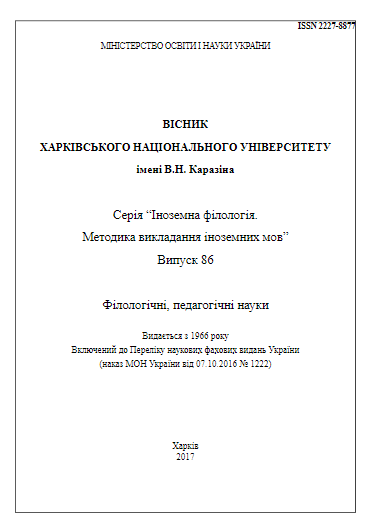Ground-figure change in three-component parataxis syntactic structures including hypotaxis
Abstract
The article introduces theoretical and methodological underpinnings and methodical tools of the cognitive-discursive analysis of complex syntactic constructions used in public speeches of B. Obama and D. Cameron. It deploys the instruments for attention cognitive construal operations analysis to identify the patterns of the ground-figure change in three-component parataxis syntactic structures including hypotaxis. Featured in public speeches of B. Obama and D. Cameron there are three types of semantic relations involved in constructing three-component parataxis syntactic structures including hypotaxis: structural-semantic incorporation, semantic incorporation and chain attachment. These types of syntactic relations are viewed in terms of cognitive construal operations of attention control.
Semantic incorporation represents a nonlinear type of hypotaxis relations where the subordinate predication serves as the ground setting the time, cause / precondition or epistemic framework of the event, expressed by the main predication functioning as the figure. Structural-semantic incorporation and chain attachment are linear types of hypotaxis relations where preceding predication in the syntagmatic chain contains information serving as the ground for the interpretation of the subsequent predication, functioning as the figure.
In a sentence built by structural-semantic incorporation and chain attachment the focus of attention is moved progressively in a syntagmatic chain. It is explained by the linear type of ground-figure change, characteristic of the types of syntactic arrangement engaged. In a sentence involving semantic incorporation the focus of attention is determined by the position of the main clause, introduced by semantic incorporation. So the focus of attention can move progressively and regressively.
Downloads
References
Мартынюк А.П. Когнитивно-дискурсивный инструментарий анализа сложноподчиненного синтаксиса англоязычного политического дискурса [Электронный ресурс] / А.П. Мартынюк., А.Ю. Поникарева // Когниция, коммуникация, дискурс : междунар. электронный сб. науч. ст. – 2013. – №7. – С. 68–80. – Режим доступа : https://sites.google.com/site/cognitiondiscourse/ vypusk-no7-2013/martynuk-a-p-ponikareva-a-u.
Chafe W.L. Discourse, consciousness and time: the flow and displacement of conscious experience in speaking and writing / W.L. Chafe. – Chicago : Chicago University Press, 1994. – 327 p.
Croft W. Cognitive Linguistics / W. Croft, D.A. Cruse. – Cambridge : Cambridge University Press, 2004. – 356 p.
Langaсker R.W. Foundations of Cognitive Grammar : Theoretical prerequisities / R.W. Langaсker. – Stanford : Stanford University Press, 1987. – Vol. 1. – 395 p.
Langacker R.W. Grammar and conceptualization. / R.W. Langacker. – Berlin: Mouton de Gruyter, 1999. – 433 p.
Talmy L. Semantic structures in English and Atsugewi. Ph. D. dissertation, Department of Linguistics, Un-ty of California, Berkeley, 1972.
Talmy L. Rubber sheet cognition in language / L. Talmy // Papers from the 13th Regional Meeting, Chicago Linguistic Society ; [ed. W.A. Beach]. – Chicago : Chicago Linguistic Society, 1977. – P. 612–628.
Talmy L. The relation of grammar to cognition / L. Talmy // Topics in cognitive linguistics ; [ed. B. Rudzka-Ostyn]. – Amsterdam : John Benjamins, 1982. – 165–205.
Talmy L. Toward a cognitive semantics / L. Talmy. – Cambridge (Mass.); L. : A Bradford Book, The MIT Press, 2000. – Vol. 1. Concept Structuring Systems. – 565 p.




